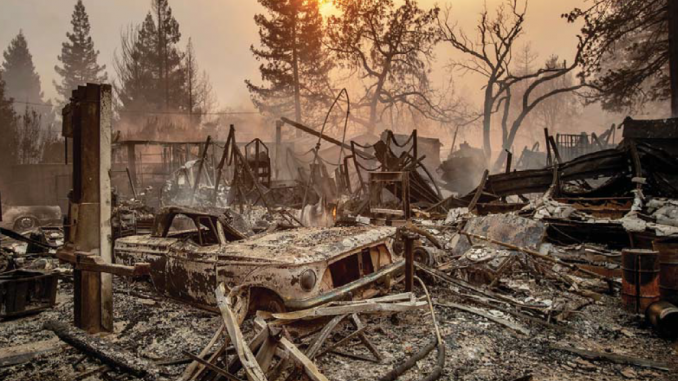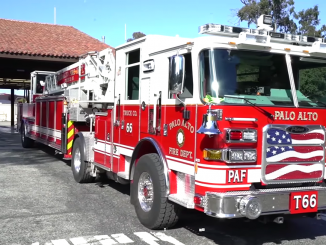
BY EMILY MIBACH AND ALLISON LEVITSKY
Daily Post Staff Writers
The latest fire to destroy a California town — the Camp Fire in Butte County — has raised the concern of whether a similar firestorm is likely on the mid-Peninsula.
“The short answer is that it could happen anywhere,” said Menlo Park Fire Protection District Chief Harold Schapelhouman.
However, both Schapelhouman and Palo Alto Fire Chief Eric Nickel said the mid-Peninsula’s terrain and proximity to the Bay make it much different than Butte County.
“The fuels are different, we get significantly more moisture when the fog comes in, and for every 10 times you would get a red flag warning up in Paradise, we might get one,” Nickel said. “When we do get these north winds it’s blowing the fire away from Palo Alto, so if we did have a fire start in the foothills it would basically blow it over toward the coast.”
“Thank God for the ocean and the Bay and all the things that help us so our chances are less, but you can’t say they don’t exist,” Schapelhouman said.
In the foothills
But Schapelhouman said he’s concerned about a fire starting in the area between Skyline Boulevard and Interstate 280 and getting out of control. When Schapelhouman first started working in Menlo Park in the early 1980s, there was a fire near Arastradero Road that destroyed houses up in the hills. He said the fire could have been more devastating, but they had the good fortune of the wind changing direction and stopping the fire from spreading farther.
Ken Dueker, Palo Alto’s emergency response director, said the scenario that worries him the most is a major earthquake that leads to a devastating fire, like in 1906, or a fire in which resources run out or are not positioned properly.
“What concerns me is that there are cases where you’re just out of resources, or your resources cannot get to you in a timely way,” Dueker said.
Nickel said that the fire departments work to analyze the risks of fires and try to mitigate them.
The Santa Clara County Fire Safety Council organizes residents, fire departments and foresters and secures grant funds to create safe exit routes in case of a wildfire. The city of Palo Alto puts in about $250,000 per year to help clear the foothills and the Midpeninsula Regional Open Space District.
The fire department also positions fire equipment on days when there is dangerous fire weather. For example, on Thursday (Nov. 8), a red flag warning
was in effect in the foothills, so Nickel positioned a brush fire engine at Foothills Park for 24 hours.
In September, the state committed $1 billion over the next five years to provide grants to fire departments, cities, counties and nonprofits to thin brush
and cut fuel breaks in high-risk areas statewide.
“We’ve suppressed fires for so many years that the fuels have grown up,” Nickel said.
Schapelhouman said that thinning out the brush in the area is much needed. He said he’d like to see non-native plants such as eucalyptus, which has
highly flammable oils, and plants that aren’t drought-resistant get removed.
Controlled burns
Another way to get rid of the brush is by having controlled burns, but Schapelhouman said the Bay Area Air Quality Management District charges fire agencies to do them, causing Cal Fire and others to shy away from spending the money.
Schapelhouman said given the disastrous fires the state has seen in the past year, those fees ought to be waived. He likened the smoke from the controlled
burns to when water systems are flushed out and your drinking water turns brown for a few days.
“It’s a push and pull between environmental and comfort — wouldn’t you rather have the smoke from a controlled burn than from the smoke of people’s lives being destroyed?” Schapelhouman asked.
Nuisance weeds
Other mitigations are a bit more administrative. Both the Palo Alto City Council and Menlo Park Fire Protection District board declare weeds a nuisance and identify property owners with a dangerous amount of brush. If they don’t clear it, crews will do it for them and bill the landowner for the work.
“It drives people nuts when we do that, but the city is super committed to getting the brush cleared,” Nickel said.
If the landowner doesn’t pay for the brush clearance, the city puts a lien on the property.
Dueker said residents and business owners should also remove the dead leaves from their gutters and install ember-resistant eave vents to prevent embers from igniting a fire.
And in the event that there is a fire, Nickel said local agencies respond in full force.
“We will dispatch upwards of 100 firefighters on the initial response,” Nickel said.




I feel better already, since I live along Skyline Blvd. Typical Palo Alto NIMBY-ism. Clueless. Glad I left PA.
I agree with the commenter above. what about Woodside, Portola Valley, Los Altos Hills, skyline, etc? Up here we are the ones who are actually vulnerable to the fires. It’s almost wasteful how MP/PA spend their money in their towns when the likelihood of fire there is slim to none. Anyways the most expensive and biggest homes are west of 280 so I assume they should take priority compared to an area where fire risk is minimal
“Schapelhouman said the Bay Area Air Quality Management District charges fire agencies to do them [controlled burns], causing Cal Fire and others to shy away from spending the money.”
Chief Schapelhouman: how much money would BAAQMD charge you or my Fire Dept or CalFire for the controlled burns that are needed?
Removing the fallen limbs and underbrush in the hills needs to be the priority. Jerry Brown’s attempt to blame climate change is meaningless. He’s probably wrong but even if he’s right, there’s nothing we can do about it. Forest maintenance is something local, state and federal decision-makers can agree upon now.